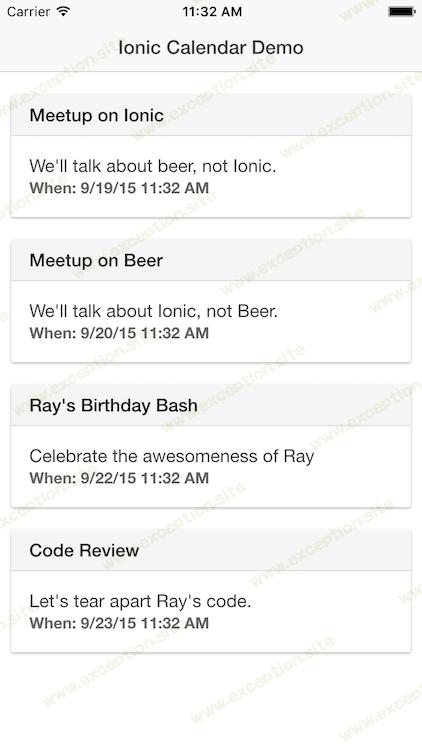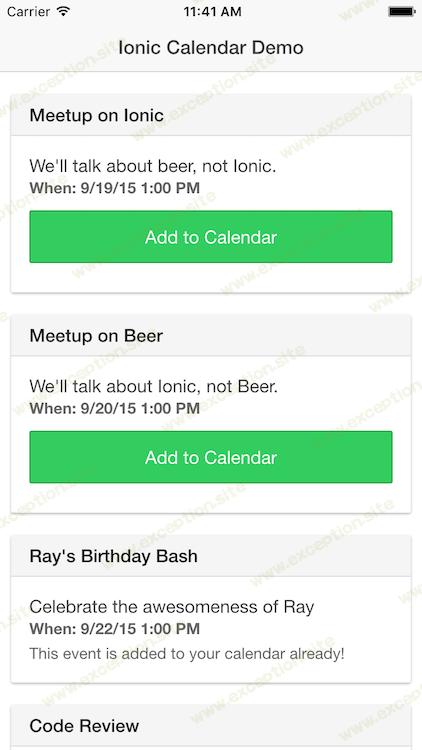将日历集成到您的 Ionic 应用程序中
💡一则或许对你有用的小广告
欢迎加入小哈的星球 ,你将获得:专属的项目实战(已更新的所有项目都能学习) / 1v1 提问 / Java 学习路线 / 学习打卡 / 每月赠书 / 社群讨论
- 新开坑项目:《Spring AI 项目实战》 正在持续爆肝中,基于 Spring AI + Spring Boot 3.x + JDK 21..., 点击查看 ;
- 《从零手撸:仿小红书(微服务架构)》 已完结,基于
Spring Cloud Alibaba + Spring Boot 3.x + JDK 17...,点击查看项目介绍 ;演示链接: http://116.62.199.48:7070 ;- 《从零手撸:前后端分离博客项目(全栈开发)》 2 期已完结,演示链接: http://116.62.199.48/ ;
截止目前, 星球 内专栏累计输出 100w+ 字,讲解图 4013+ 张,还在持续爆肝中.. 后续还会上新更多项目,目标是将 Java 领域典型的项目都整一波,如秒杀系统, 在线商城, IM 即时通讯,权限管理,Spring Cloud Alibaba 微服务等等,已有 3700+ 小伙伴加入学习 ,欢迎点击围观
对于今天的演示,我决定尝试一些我一直想花时间做的事情——与移动设备上的日历集成。幸运的是,有一个很棒的插件 ——Calendar-PhoneGap-Plugin 。这个插件提供了所有类型的本地日历挂钩,包括搜索和添加事件的能力。有了那个插件,我迅速做了一个演示。
我首先构建了一个应用程序,该应用程序仅从列表中返回事件并按原样显示它们。这是视图:

让我们看看这背后的代码。首先,HTML。由于这个应用程序非常简单,我没有使用路由和模板。
<!DOCTYPE html>
<html>
<head>
<meta charset="utf-8">
<meta name="viewport" content="initial-scale=1, maximum-scale=1, user-scalable=no, width=device-width">
<title></title>
<link href="lib/ionic/css/ionic.css" rel="stylesheet">
<link href="css/style.css" rel="stylesheet">
<!-- IF using Sass (run gulp sass first), then uncomment below and remove the CSS includes above
<link href="css/ionic.app.css" rel="stylesheet">
-->
<!-- ionic/angularjs js -->
<script src="lib/ionic/js/ionic.bundle.js"></script>
<!-- cordova script (this will be a 404 during development) -->
<script src="cordova.js"></script>
<!-- your app's js -->
<script src="js/app.js"></script>
<script src="js/controllers.js"></script>
<script src="js/services.js"></script>
</head>
<body ng-app="starter">
<ion-pane ng-controller="MainCtrl">
<ion-header-bar class="bar-stable">
<h1 class="title">Ionic Calendar Demo</h1>
</ion-header-bar>
<ion-content>
<div class="card" ng-repeat="event in events">
<div class="item item-divider">
{{event.title}}
</div>
<div class="item item-text-wrap">
{{ event.description }}
<p/>
<strong>When: {{ event.date | date:'short' }}</strong>
</div>
</div>
</ion-content>
</ion-pane>
</body>
</html>
这应该都是相当样板的。我只是循环事件并为每个事件创建一个卡片 UI。现在让我们看看控制器代码。
<!DOCTYPE html>
<html>
<head>
<meta charset="utf-8">
<meta name="viewport" content="initial-scale=1, maximum-scale=1, user-scalable=no, width=device-width">
<title></title>
<link href="lib/ionic/css/ionic.css" rel="stylesheet">
<link href="css/style.css" rel="stylesheet">
<!-- IF using Sass (run gulp sass first), then uncomment below and remove the CSS includes above
<link href="css/ionic.app.css" rel="stylesheet">
-->
<!-- ionic/angularjs js -->
<script src="lib/ionic/js/ionic.bundle.js"></script>
<!-- cordova script (this will be a 404 during development) -->
<script src="cordova.js"></script>
<!-- your app's js -->
<script src="js/app.js"></script>
<script src="js/controllers.js"></script>
<script src="js/services.js"></script>
</head>
<body ng-app="starter">
<ion-pane ng-controller="MainCtrl">
<ion-header-bar class="bar-stable">
<h1 class="title">Ionic Calendar Demo</h1>
</ion-header-bar>
<ion-content>
<div class="card" ng-repeat="event in events">
<div class="item item-divider">
{{event.title}}
</div>
<div class="item item-text-wrap">
{{ event.description }}
<p/>
<strong>When: {{ event.date | date:'short' }}</strong>
</div>
</div>
</ion-content>
</ion-pane>
</body>
</html>
是的,只需调用服务并呈现事件即可。琐碎的。现在让我们看看服务。
<!DOCTYPE html>
<html>
<head>
<meta charset="utf-8">
<meta name="viewport" content="initial-scale=1, maximum-scale=1, user-scalable=no, width=device-width">
<title></title>
<link href="lib/ionic/css/ionic.css" rel="stylesheet">
<link href="css/style.css" rel="stylesheet">
<!-- IF using Sass (run gulp sass first), then uncomment below and remove the CSS includes above
<link href="css/ionic.app.css" rel="stylesheet">
-->
<!-- ionic/angularjs js -->
<script src="lib/ionic/js/ionic.bundle.js"></script>
<!-- cordova script (this will be a 404 during development) -->
<script src="cordova.js"></script>
<!-- your app's js -->
<script src="js/app.js"></script>
<script src="js/controllers.js"></script>
<script src="js/services.js"></script>
</head>
<body ng-app="starter">
<ion-pane ng-controller="MainCtrl">
<ion-header-bar class="bar-stable">
<h1 class="title">Ionic Calendar Demo</h1>
</ion-header-bar>
<ion-content>
<div class="card" ng-repeat="event in events">
<div class="item item-divider">
{{event.title}}
</div>
<div class="item item-text-wrap">
{{ event.description }}
<p/>
<strong>When: {{ event.date | date:'short' }}</strong>
</div>
</div>
</ion-content>
</ion-pane>
</body>
</html>
好的,所以这有点复杂。我有一组假数据,可以在未来创建四个事件。该服务然后返回那些假事件。好的,让我们把它提高一个档次。鉴于我们的日历插件可以检查事件,我将更新我的代码以显示事件是否已添加到日历中。这是一个例子。

在此屏幕截图中,您可以看到用于将事件添加到日历的按钮。请注意,第三个事件虽然被识别为在日历中。为了完成这项工作,我更新了事件的服务调用以处理检查日历。这有点复杂,因为每个调用都是异步的,但是 $q 可以很容易地处理它。
<!DOCTYPE html>
<html>
<head>
<meta charset="utf-8">
<meta name="viewport" content="initial-scale=1, maximum-scale=1, user-scalable=no, width=device-width">
<title></title>
<link href="lib/ionic/css/ionic.css" rel="stylesheet">
<link href="css/style.css" rel="stylesheet">
<!-- IF using Sass (run gulp sass first), then uncomment below and remove the CSS includes above
<link href="css/ionic.app.css" rel="stylesheet">
-->
<!-- ionic/angularjs js -->
<script src="lib/ionic/js/ionic.bundle.js"></script>
<!-- cordova script (this will be a 404 during development) -->
<script src="cordova.js"></script>
<!-- your app's js -->
<script src="js/app.js"></script>
<script src="js/controllers.js"></script>
<script src="js/services.js"></script>
</head>
<body ng-app="starter">
<ion-pane ng-controller="MainCtrl">
<ion-header-bar class="bar-stable">
<h1 class="title">Ionic Calendar Demo</h1>
</ion-header-bar>
<ion-content>
<div class="card" ng-repeat="event in events">
<div class="item item-divider">
{{event.title}}
</div>
<div class="item item-text-wrap">
{{ event.description }}
<p/>
<strong>When: {{ event.date | date:'short' }}</strong>
</div>
</div>
</ion-content>
</ion-pane>
</body>
</html>
我在事件上设置一个状态值来表示事件是否存在。回到显示端,我这样处理:
<!DOCTYPE html>
<html>
<head>
<meta charset="utf-8">
<meta name="viewport" content="initial-scale=1, maximum-scale=1, user-scalable=no, width=device-width">
<title></title>
<link href="lib/ionic/css/ionic.css" rel="stylesheet">
<link href="css/style.css" rel="stylesheet">
<!-- IF using Sass (run gulp sass first), then uncomment below and remove the CSS includes above
<link href="css/ionic.app.css" rel="stylesheet">
-->
<!-- ionic/angularjs js -->
<script src="lib/ionic/js/ionic.bundle.js"></script>
<!-- cordova script (this will be a 404 during development) -->
<script src="cordova.js"></script>
<!-- your app's js -->
<script src="js/app.js"></script>
<script src="js/controllers.js"></script>
<script src="js/services.js"></script>
</head>
<body ng-app="starter">
<ion-pane ng-controller="MainCtrl">
<ion-header-bar class="bar-stable">
<h1 class="title">Ionic Calendar Demo</h1>
</ion-header-bar>
<ion-content>
<div class="card" ng-repeat="event in events">
<div class="item item-divider">
{{event.title}}
</div>
<div class="item item-text-wrap">
{{ event.description }}
<p/>
<strong>When: {{ event.date | date:'short' }}</strong>
</div>
</div>
</ion-content>
</ion-pane>
</body>
</html>
很简单,对吧?现在让我们看看添加代码。我将跳过控制器代码,因为它所做的只是调用服务并更新范围。
<!DOCTYPE html>
<html>
<head>
<meta charset="utf-8">
<meta name="viewport" content="initial-scale=1, maximum-scale=1, user-scalable=no, width=device-width">
<title></title>
<link href="lib/ionic/css/ionic.css" rel="stylesheet">
<link href="css/style.css" rel="stylesheet">
<!-- IF using Sass (run gulp sass first), then uncomment below and remove the CSS includes above
<link href="css/ionic.app.css" rel="stylesheet">
-->
<!-- ionic/angularjs js -->
<script src="lib/ionic/js/ionic.bundle.js"></script>
<!-- cordova script (this will be a 404 during development) -->
<script src="cordova.js"></script>
<!-- your app's js -->
<script src="js/app.js"></script>
<script src="js/controllers.js"></script>
<script src="js/services.js"></script>
</head>
<body ng-app="starter">
<ion-pane ng-controller="MainCtrl">
<ion-header-bar class="bar-stable">
<h1 class="title">Ionic Calendar Demo</h1>
</ion-header-bar>
<ion-content>
<div class="card" ng-repeat="event in events">
<div class="item item-divider">
{{event.title}}
</div>
<div class="item item-text-wrap">
{{ event.description }}
<p/>
<strong>When: {{ event.date | date:'short' }}</strong>
</div>
</div>
</ion-content>
</ion-pane>
</body>
</html>
只是为了证明它有效——这是我刚刚添加的事件:

我已将此演示的完整源代码放在 GitHub 上:https: //github.com/cfjedimaster/Cordova-Examples/tree/master/calendarionic 。我要非常感谢 Eddy Verbruggen 帮助我使用他的插件,并修复了我遇到的错误!
 异常教程
异常教程